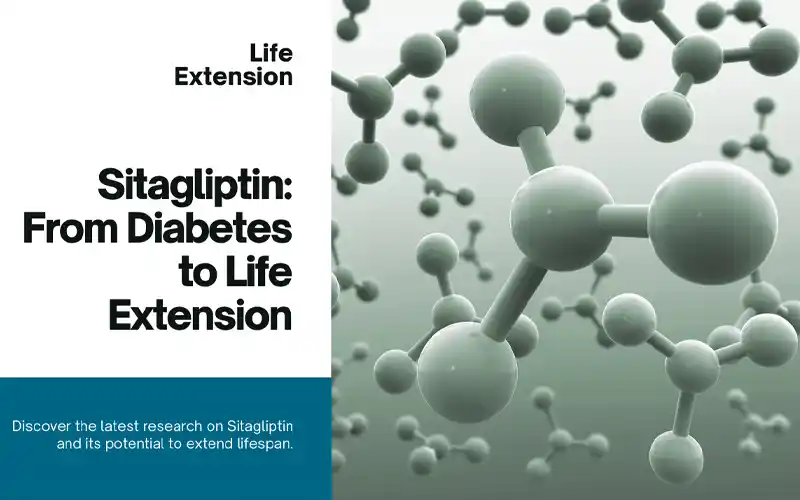The journey of Sitagliptin and longevity research marks a significant leap in our understanding of aging and how we can potentially extend human lifespan. Sitagliptin, traditionally used to manage diabetes, has emerged as a promising candidate in the anti-aging realm, thanks to groundbreaking studies involving model organisms like C. elegans.
Furthermore, Sitagliptin and longevity studies pave the way for reimagining the use of existing medications to combat aging. The repurposing of drugs like Sitagliptin represents a cost-effective and efficient strategy to address the challenges of aging, leveraging existing pharmacological knowledge for new therapeutic purposes.
As Sitagliptin and longevity research progresses, it becomes increasingly clear that the potential of Sitagliptin to act as an anti-aging agent warrants further exploration. With a growing aging population seeking ways to maintain health and vitality, the study of Sitagliptin and longevity offers a beacon of hope, hinting at a future where aging can be managed more effectively, enhancing quality of life for many.
Understanding Sitagliptin
Sitagliptin’s primary function as a DPP-4 inhibitor helps manage blood sugar levels by enhancing the body’s insulin response. However, its role in the anti-aging domain has sparked interest among scientists and researchers alike. Recent research utilizing C. elegans has showcased Sitagliptin and longevity intertwined in a fascinating dance of science, revealing that Sitagliptin significantly extends the healthspan and lifespan of these organisms. The implications of these findings suggest that Sitagliptin’s mechanism may indeed transcend its initial purpose, opening doors to potential anti-aging therapies.
The molecular underpinnings of Sitagliptin and longevity research highlight its influence on critical transcription factors associated with aging, such as DAF-16/FOXO, SKN-1/NRF2, and HSF-1. These factors play pivotal roles in extending lifespan, largely through pathways related to dietary restriction and enhanced mitochondrial function. This connection between Sitagliptin and longevity suggests a complex interaction with the body’s aging process, pointing to a holistic approach to extending life.
Sitagliptin and Longevity: Insights from C. elegans Studies
Recent research has pivoted towards examining the effects of Sitagliptin on healthspan and lifespan, with the nematode Caenorhabditis elegans serving as the model organism for these investigations (A4M Blog). These studies have yielded fascinating results, revealing that Sitagliptin significantly extends both the healthspan and lifespan of these worms. The molecular mechanisms underpinning these effects involve critical transcription factors associated with longevity, such as DAF-16/FOXO, SKN-1/NRF2, and HSF-1, which play pivotal roles in Sitagliptin-induced longevity.
Mechanisms of Action: Beyond Glucose Control
The potential of Sitagliptin to act as an anti-aging agent is thought to extend beyond its capacity to modulate blood sugar levels. Research suggests that Sitagliptin’s longevity-promoting effects may also be attributed to its ability to modulate insulin signaling pathways, akin to the mechanisms triggered by caloric restriction—a well-known intervention to extend lifespan in various organisms. This modulation may activate pathways linked to improved mitochondrial function and dietary restriction benefits, hinting at a complex interplay between metabolism, aging, and longevity.
Implications for Human Health and Aging
The implications of Sitagliptin’s potential anti-aging effects are vast. If these findings can be replicated and expanded upon in mammalian models, including humans, it could pave the way for repurposing Sitagliptin as a novel anti-aging intervention. This would not only offer a new lease on life for the aging population but also provide a compelling example of how drugs developed for one purpose could have serendipitous benefits in completely unrelated areas.
The Future of Sitagliptin in Anti-Aging Research
While the research on Sitagliptin’s role in extending lifespan is still in its infancy, the preliminary data from C. elegans studies are undeniably promising. Moving forward, rigorous clinical trials and comprehensive studies are required to understand the full spectrum of Sitagliptin’s effects on aging and longevity in humans. These investigations will not only elucidate the mechanisms through which Sitagliptin may exert its anti-aging effects but also help identify potential side effects and optimal dosing strategies for long-term use.
The journey of Sitagliptin from a diabetes treatment to a potential anti-aging therapy highlights the importance of looking beyond the conventional uses of existing drugs. As research continues to unfold, Sitagliptin may well become a cornerstone in the evolving narrative of how modern medicine approaches the challenges of aging and longevity.
References:
A4M. (2023). Sitagliptin’s Potential Beyond Diabetes: Initially recognized for its ability to lower blood sugar, Sitagliptin is now being investigated for its potential to extend healthspan and lifespan, demonstrating promising results in C. elegans as a model organism. Retrieved from https://blog.a4m.com/sitagliptins-potential-beyond-diabetes/
To Learn More:
The Future is Now: Artificial Chromosomes and the New Dawn of Human Enhancement
Unleashing Potential: How DIY CRISPR Kits Empower Personal Genetic Innovation
Transforming Lives: Revolutionary Bioprinting and Genetic Engineering of Organs





